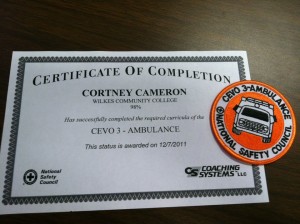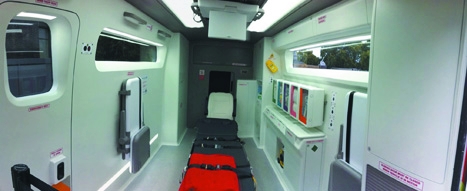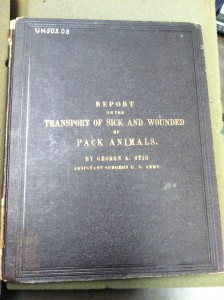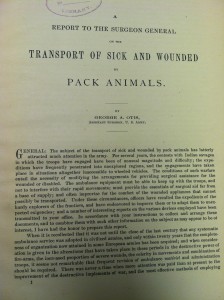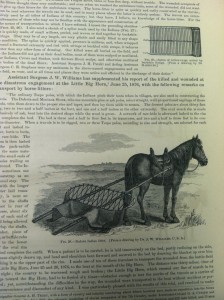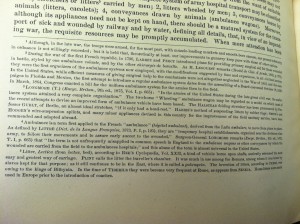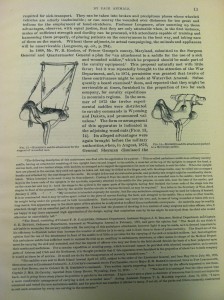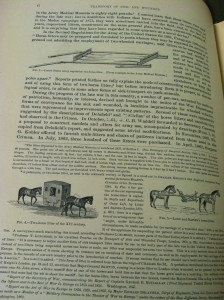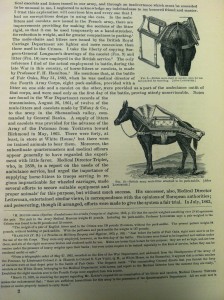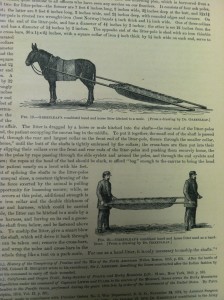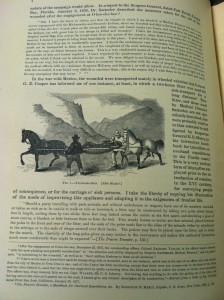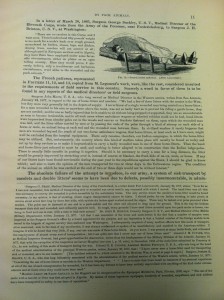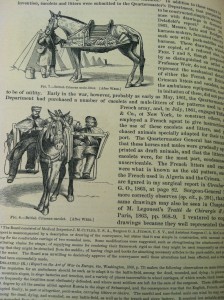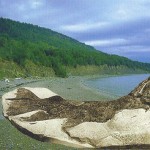Note: This entry was originally posted on a blog I created for my History of Medicine class final project during December 2012.

1958 Cadillac Combination Car © That Hardford Guy
The year is 1953 and a bad wreck has just occurred. One of the passengers involved seems to have broken his femur. A bystander who has pulled over to help yells, "Quick, call the funeral home! We need a hearse, stat!"
For many members of the public, the medic is synonymous with the ambulance, and understandably so, since a good deal of of the medic's work occurs within its walls. This vehicle, stereotypically a large box-like one replete with lights and the Star of Life plastered on every side (and sometimes even the roof so that critical care helicopters can quickly identify it!), represents hope. I've been on both sides of the ambulance story -- as an EMT rendering care and as a 16-year-old watching my father suffer a heart attack -- and I think it goes without saying that when you or your loved one is in the middle of a medical crisis, it is reassuring when somebody arrives on scene -- dressed in a uniform and wielding fancy equipment -- who can take the situation out of your hands and form a plan of action. However, once upon a time, the vehicle that responded to emergencies was perhaps the anti-thesis of hope and in fact represented, if anything, death: that vehicle was the hearse.
By now, though, the story of ambulance as hope is so embedded in our culture that we take it for granted. However, like most things in medicine, it did not arise in a vacuum or suddenly materialize out of the blue. In fact, some safety professionals claim that the old roots of the motorized ambulance are painfully apparent, lamenting that the typical ambulance design is outdated and therefore needlessly dangerous (see my section on the future of the ambulance below). Nobody ever sat down and decided that the current setup would work best for transporting patients and providing care en route. Starting in the eighties, the US federal government did lay down some regulations on how ambulances should look, but the extent of the legislation was to make them a protected, recognizable entity; utility was left out of the equation. Instead, the modern ambulance was a natural consequence of its predecessor -- the hearse -- when it was never intended that care would be administered outside of the hospital, certainly not in a moving vehicle, of all places.
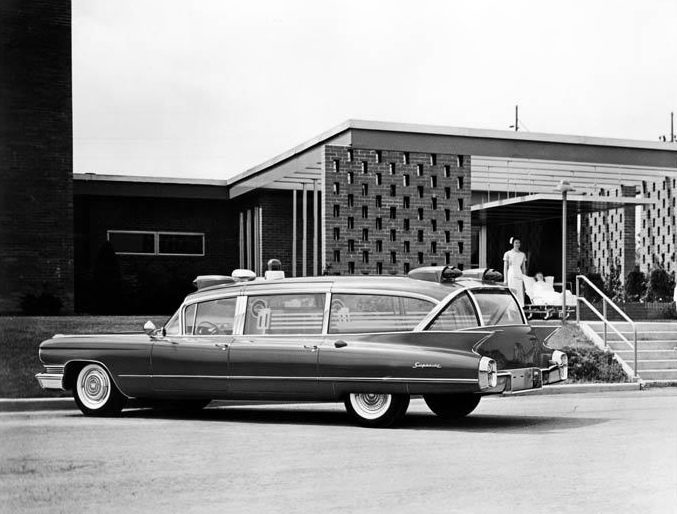
1960 Cadillac © That Hardford Guy
It's true that some areas had legitimate ambulance services well ahead of their time; Cincinnati is widely credited as the first, having started a horse and carriage system in 1865 that provided an intern for the patient. However, with the exception of these outliers, which for the most part took place in large cities, most areas did not have any form of organized emergency medical services until well after the 1960s (click link to download an excellent 1976 article from the Journal of Trauma on the history of EMS). Therefore, when somebody was injured or fell ill, the emphasis was solely on getting that person to the hospital as quickly as possible, where definitive care could be provided. In the 20th century, the fastest method was clearly the automobile. Any old passenger car might suffice for some cases, but others simply didn't allow for one to fold up a patient into a car seat, front or back. Particularly with extensive trauma, even for bystanders without medical training and before the advent of back boarding protocols, it must have been obvious that the supine position was the most viable and relatively comfortable way to transport a patient without exacerbating any injuries. The hearse made a great vehicle for these cases: it was ready-made to transport a laid-out body, and unlike a truck, it was enclosed and offered the patient protection from the elements). See AAOS, page 7.
I attended EMT school in Wilkes, NC, a county which contains mountainous areas, along with US Route 421, which has existed in one form or another since the 1930's. One of my classmates, Jon, was a 40-year-old man whose grandfather had actually worked for a funeral home in the county through the 50's and 60's as a way to make a living after he served during World War 2, and he shared with me his grandfather's accounts. People wrecked frequently on the curvy slopes of 421, and it fell upon the funeral homes to provide hearses to transport patients. The funeral homes would scan the radio for reports of wrecks so that they could respond. (Remember, 9-1-1 did not become the standard emergency number in the US until 1968, and even then, it wasn't widely implemented. In fact, as late as the 2000s, some rural areas didn't use 9-1-1; rather, callers would have to memorize and dial a seven digit number to reach the police, fire, or EMS.)
In Wilkes county at the time, there were two main funeral homes -- one of them, Reins Sturdivant, even mentions on its website that it ran an ambulance service until 1967. According to Jon, his grandfather said that the two funeral homes would have employees religiously track the radio. Upon getting word of a wreck, each would immediately dispatch a hearse. In the best case scenarios, they'd arrive to find the patient in fairly good condition, and as needed, they'd run the patient to the hospital. However, in the worst case scenarios, they'd arrive to find the patient rapidly deteriorating or already dead; these cases, as it turns out, were the most profitable. As grieving family members rarely wanted to deal with the logistics of a dead body, the funeral home that already had the body usually got the business. Therefore, the funeral homes had an incentive to be the first on scene, and this resulted in humorous stories of hearses drag racing down the mountainsides to get to wrecks. The psychological impact of seeing a hearse rushing toward you in your moment of truth must have been interesting, to say the least. (I haven't been able to figure out if the funeral homes received fees for their ambulatory services or if their less fortunate patients provided enough income to man the entire operation, but generally speaking, I think that patients who survived the trip escaped the bill.)
Automobile manufacturers were quite aware of the dual roles that their hearses were playing, and as early as the late 1950's, this gave rise to the "combination car" that was built for the specific purpose of easily switching between ambulance use and hearse use. Although these ambulances were still just re-fitted hearses, the trend toward a care-oriented vehicle is clear. Within several years, the combination car would shed its hearse role entirely to become a dedicated emergency vehicle, the ambulance. Although the two vehicles still had similar body styles, advertisements began emphasizing head room, compartments, and the inclusion of a attendant's chair.
Despite the fact that these models were offered, keep in mind that their adoption would have varied considerably. My grandfather, a retired lieutenant from a fire department in Florida, mentioned that when he started working for the department in the late seventies, their first rescue truck was just an old bread truck that they'd converted for the job. Still, the ambulance as a dedicated vehicle had come to stay, and by the late 80's, most ambulances were large vans.
Today, although culturally it has broken most ties with the hearse, the modern ambulance bares resemblance to its forefather -- the compartment has just been increased in size!
Bonus: You've seen a few advertisements for ambulances from the 50's and 70's; for loads more, visit this Flickr stream. To compare, look at Ford's brochure for its current ambulance offerings.
The future of the ambulance
The ambulance design is far from perfected and there are ongoing efforts to find the ideal vehicle setup, and with good reason. "Transportation incidents are the leading cause of work-related deaths in the United States," a 2011 CDC study noted. "The fatality rate for EMS workers was more than 2 times the national average." Several factors play into these higher rates, including:
- The amount of time EMS workers spend on the road means they are simply exposed more often to transportation incidents.
- Emergency vehicles are authorized to circumvent some traffic laws, allowing them to travel at higher speeds and bypass stop signals, which increases the likelihood of accidents and also the potential severity of the accidents.
- Perhaps most importantly, EMS personnel tending to a patient in the back of the ambulance rarely wear safety restraints, since doing so would impede with care. In a crash, the medic can become a ping pong ball in a big metal box with lots of sharp edges.
The first risk factor is an unavoidable part of the job. The second, however, is being addressed largely through educational programs (such as CEVO-3; see the image of my certificate) that teach medics best practices for the safe driving of emergency vehicles, the completion of which many services now require as a condition of employment. Another area of improvement has sought to by increase the visibility of emergency vehicles, so that other drivers are more likely to notice them and respond accordingly. For example, studies show that in dark lighting conditions, the human eye can detect lime green much sooner than firetruck bright red (Emergency Vehicle Operations, Lindsey & Patrick, 2006), so some services have been moving away from traditional red-themed ambulance color schemes.
For the third factor, most recently, Life EMS in the US and the NHS in the UK have both offered innovative designs that not only implement optimal coloring, but also seek to make ambulances safer and more efficient for medics in much more in-depth ways. As The Engineer pointed out in its excellent writeup on the new NHS design released in January 2012, "the ambulance has changed very little in the past 30 years or so." Accordingly, the NHS found that "the ambulance interior is difficult to keep clean and paramedics suffer from poor layout and ergonomics." To resolve this, the NHS design features a molded, curved surface that not only removes pointed edges, but eliminates crevices that might pose sanitation problems. Furthermore, the stretcher has been moved to the middle of the ambulance to allow 360° access, and medical supplies were organized hierarchically and placed into easy-access compartments. Similarly, the Life EMS design (released in November 2012) maximizes space, places equipment within reach, adds better light, implements rounded edges, and hopes to improve patient experience with artwork. Both designs offer promising insights into the future of the ambulance and how to make medics' work safer and more efficient, which can only spell good things for patients.
Disclaimer
I want to point out that ambulances come in more shapes and sizes than one could feasibly cover in a single blog post, since depending on the geography, climate, and population of an area, a service might elect for anything from a bicycle that can quickly navigate crowded city streets to a 4WD truck that can handle muddy slopes. For similar reasons of cost, location, and population, the chronological implementation of various ambulance systems has varied greatly across jurisdictions, by up to decades, in some cases. So, for the sake of simplicity, I focused on the more "mainstream" ambulance (those based on the chassis-cabs of light duty pickup-trucks or vans) and its evolution as a motorized vehicle. In this post, I've only considered the civilian side of EMS in the United States, as the US military was actually employing dedicated ambulance vehicles in World War I. For those interested, Wikipedia has a great overview of the many ambulances types found in the modern day, while Katherine Barkley's The Ambulance covers emergency medical transportation schemes from ancient times on. [Update: I found a great book in Special Collections that covers some ambulances in use in the late 1800's, so I'm sharing a few pictures below.]
Bonus: So what were they using before motorized vehicles?
In 1877, US Army Assistant Surgeon George Otis published A report to the Surgeon General on the transport of sick and wounded by pack animals (read full text online here). Otis did a thorough job of covering many different ambulances in use at the time by different groups and countries, and he called for the need for the Army to develop a better ambulance system. Otis argued that not only did ambulances allow soldiers to receive proper medical treatment, but that it also improved a nation's ability to fight. When soldiers could rest assured that would be taken care of in the event of an injury, morale was increased. As proof of this concept, Otis quoted one soldier who credits the French successes in Algeria on the spirit-lifting capabilities on the ambulance (read about the French system in this post). Additionally, Otis pointed out that many military wartime systems and instruments were useless to countries during peacetime, which sometimes made it difficult to justify their expense. However, ambulances could be utilized during peacetime to assist civilian populations (although as we'll see, military techniques took years to appear in civilian life). Finally, an effective ambulance could be assembled using simple materials. Otis felt that taking all of these facts into account, there was simply no reason for an army to neglect its ambulance. I've copied a passage below. (Imagine that you are injured and riding in one of these designs. Some of them left one precariously placed on a mule or horse. One could only hope the animals were trained well!)
"The subject of the transport of sick and wounded by pack animals has latterly attracted much attention in the army... The conditions of such warfare [in treacherous terrain] entail the necessity of modifying the arrangements for providing surgical assistance for the wounded or disabled. The ambulance equipment must be able to keep up with the troops, and not to interfere with their rapid movements; must provide the essentials of surgical aid far from abase of supply; and often improvise for the comfort of the wounded appliances that cannot possibly be transported.
"When it is recollected that it was not until the close of the last century that any systematic ambulance service was adopted in civilized armies, and only within twenty years that the completeness of organization now attained in some European armies has been acquired; and when consideration is given to the alterations that have taken place in these periods in the destructive power of fire-arms, the increased proportion of severe wounds, the celerity in movements and combination of troops, it seems not remarkable that frequent revision of ambulance material and administration should be required. There was never a time when more attention was paid than at present to the improvement of the destructive implements of war, and the most effective methods of employing them, and it is assuredly of pressing necessity that corresponding efforts should be made for the abridgment or mitigation of the sufferings and preservation of the lives of those exposed to such formidable means of aggression. For the interests of the sick and wounded are not alone involved in the efficiency with which the ambulance service is performed.
"The strategic plans of the commander are promoted or thwarted according as the work is done well or ill; and, above all, the spirit of the soldiers, their tone of feeling and confidence in time of danger, is much affected by their estimate of the provision made for their succor, should they be disabled in action. A veteran soldier, Marshal Bugeaud, after his African victories, declared that 'the courage of the French troops would not perhaps have sufficed for the conquest of Algeria, if we had not been able to save the sick and wounded from the Arabs.' It is not to be supposed that any neglect in providing for the comfort of sick and wounded men will be without depressing influence on the morale of troops of our army employed in Indian hostilities, and inspired with a traditional dread of the tortures that await them should they fall captives to their savage opponents.
"Fortunately, progress in the improvement of the equipment provided for the ambulance service tends to simplicity rather than complexity. The costliness of maintaining, in time of peace, establishments required only in time of war, is an argument often urged against all branches of the military service, which, whatever its relevancy to armaments of war in general, has little validity as applied to the ambulance service. The greater part of its material can be utilized in time of peace; its necessary outfit need not be large or extravagantly expensive. But it is of the last importance, as long as the necessity of standing armies is accepted, that the sanitary appliances furnished should be the best of their kind, that, when an emergency arises, there may not be a lavish outlay for unserviceable material, nor avoidable suffering from the want of suitable equipment. The material required in a complete system of army hospital transport may be classified as: 1, stretchers or litters 5 carried by men; 2, litters wheeled by men; 3, conveyances borne by animals (litters, cacolets); 4, conveyances drawn by animals (ambulance wagons). Moreover, although its appliances need not be kept on hand, there should be a matured system for the transport of sick aud wounded by railway and by water, defining all details, that, in view of an impending war, the requisite resources may be promptly accumulated."



